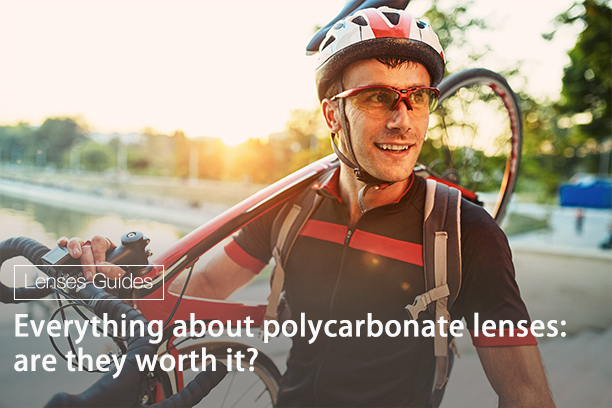- GlassesShop By FrameShop By StyleFeatured












Polycarbonate lenses have emerged as a significant innovation in the world of eyewear. Renowned for their durability, impact resistance, and lightweight design, these lenses have become a popular choice for eyeglasses and sunglasses.

Polycarbonate lenses are a form of glasses lenses crafted from a unique form of plastic known as polycarbonate. These lenses are known for their unique characteristics and are commonly used in eyewear for various purposes.
One of the primary features of polycarbonate lenses is their exceptional impact resistance. They are highly durable and can withstand impact without shattering, making them ideal for safety and sports glasses.
And they are significantly lighter than traditional glass lenses. This lightweight property makes them comfortable to wear for extended periods.
Polycarbonate lenses offer several advantages that make them a popular choice for eyewear. Here are the key advantages of polycarbonate lenses:
1. Impact resistance
Polycarbonate lenses are known for their exceptional impact resistance. They are virtually unbreakable and can withstand significant force without shattering. This property makes them ideal for safety glasses, sports glasses, and protective goggles, providing crucial eye protection in various environments.
2. Lightweight
Polycarbonate lenses are significantly lighter than traditional glass lenses. It reduces the burden on the bridge of the nose and behind the ears, making them an excellent choice for individuals who wear eyeglasses throughout the day.
3. Uv protection
Many polycarbonate lenses come with built-in uv protection. They block harmful ultraviolet (uv) rays from the sun, helping to safeguard the eyes from uv-induced damage. This feature is essential for maintaining eye health and reducing the risk of conditions like cataracts and macular degeneration.
4. Thin profile
Despite their impressive impact resistance, polycarbonate lenses can be crafted into thin profiles. This reduces the overall thickness and weight of eyeglasses, resulting in a sleek and aesthetically pleasing appearance.
5. Scratch resistance
While no lens material is entirely scratch-proof, polycarbonate lenses are more resistant to scratches compared to some other materials like plastic. This durability ensures that your eyeglasses maintain optical clarity and visual performance over time, even in demanding conditions.
6. Thinner edges
Polycarbonate lenses have thinner edges compared to some other lens materials. This thinness can enhance the aesthetics of eyeglasses, providing a more streamlined and modern look.
While polycarbonate lenses offer numerous advantages, they also have some disadvantages that individuals should consider when choosing eyewear.
1. Optical clarity
Polycarbonate lenses may not provide the same optical clarity as some other lens materials, such as high-index lenses or glass. They can exhibit more chromatic aberration, leading to color fringing or distortion around the edges of objects. However, advances in lens technology have mitigated this issue in many modern polycarbonate lenses.
2. Thinner edges
While thin edges are an advantage for aesthetics, they can also be a disadvantage for individuals with higher prescriptions. In some cases, especially for strong prescriptions, polycarbonate lenses with thin edges may not be the best choice, as they can cause more pronounced magnification and minification effects.
3. Cost
Polycarbonate lenses tend to be more expensive than standard plastic lenses but may be on par with or slightly less expensive than high index lenses. The added cost is often due to the manufacturing process required to achieve their unique properties.
4. Limited tint options
Polycarbonate lenses may have limited options for tinting compared to some other materials like glass. If you require specific tint colors or gradients for sunglasses, you may have fewer choices with polycarbonate lenses.
Polycarbonate lenses are worth considering for many individuals, but whether they are the right choice depends on various factors, including your specific needs and preferences.
1. Children and active individuals
Polycarbonate lenses are a top choice for children's eyewear due to their durability and impact resistance. Active individuals who participate in sports or outdoor activities may also benefit from the lightweight and protective nature of these lenses.
2. Safety and work environments
People working in industries where eye safety is paramount, such as construction or manufacturing, can benefit from the impact resistance of polycarbonate lenses. They offer an added layer of protection against workplace hazards.
3. Budget considerations
While polycarbonate lenses may be more expensive than standard plastic lenses, they can be more budget-friendly than high-index lenses. If you're looking for a balance between performance and cost, polycarbonate lenses can be a good choice.
Material: Made from polycarbonate, a type of plastic.
Pros: Exceptional impact resistance, lightweight, uv protection, suitable for sports and safety eyewear, compatible with a wide range of prescriptions.
Cons: Can have more noticeable chromatic aberration, limited tint options, may not be the best choice for very high prescriptions.
Material: Made from high-index plastic or glass.
Pros: Thinner and lighter than standard plastic or glass lenses, excellent optical clarity, reduced magnification/minification effects for high prescriptions, versatile for various frame styles.
Cons: Typically more expensive than polycarbonate lenses, may not provide the same level of impact resistance.
Material: Made from a standard plastic known as cr-39.
Pros: Typically less expensive than polycarbonate, good optical clarity, available in various tint options, suitable for most prescription strengths.
Cons: Not as impact-resistant as polycarbonate, heavier and thicker, may not be ideal for high prescriptions.

